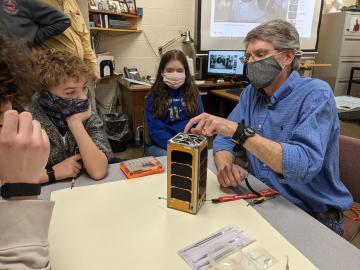
Filter News
Area of Research
- (-) Supercomputing (64)
- Advanced Manufacturing (1)
- Biological Systems (1)
- Biology and Environment (87)
- Biology and Soft Matter (1)
- Computational Biology (1)
- Computational Engineering (1)
- Computer Science (1)
- Energy Science (49)
- Fusion and Fission (10)
- Fusion Energy (1)
- Isotopes (6)
- Materials (24)
- Materials for Computing (2)
- National Security (25)
- Neutron Science (19)
- Nuclear Science and Technology (7)
- Quantum information Science (1)
News Type
News Topics
- (-) Biomedical (12)
- (-) Cybersecurity (8)
- (-) Environment (17)
- (-) Frontier (29)
- (-) Simulation (13)
- 3-D Printing/Advanced Manufacturing (5)
- Artificial Intelligence (34)
- Big Data (17)
- Bioenergy (9)
- Biology (10)
- Biotechnology (2)
- Buildings (3)
- Chemical Sciences (4)
- Computer Science (77)
- Coronavirus (12)
- Energy Storage (6)
- Exascale Computing (23)
- Grid (4)
- High-Performance Computing (36)
- Isotopes (2)
- Machine Learning (13)
- Materials (12)
- Materials Science (14)
- Mathematics (2)
- Microscopy (7)
- Molten Salt (1)
- Nanotechnology (10)
- National Security (8)
- Neutron Science (13)
- Nuclear Energy (3)
- Partnerships (1)
- Physics (8)
- Quantum Computing (16)
- Quantum Science (21)
- Security (6)
- Software (1)
- Space Exploration (2)
- Summit (36)
- Transportation (5)
Media Contacts

Improved data, models and analyses from ORNL scientists and many other researchers in the latest global climate assessment report provide new levels of certainty about what the future holds for the planet

An ORNL-led team comprising researchers from multiple DOE national laboratories is using artificial intelligence and computational screening techniques – in combination with experimental validation – to identify and design five promising drug therapy approaches to target the SARS-CoV-2 virus.

RamSat’s mission is to take pictures of the forests around Gatlinburg, which were destroyed by wildfire in 2016. The mission is wholly designed and carried out by students, teachers and mentors, with support from numerous organizations, including Oak Ridge National Laboratory.

The U.S. Department of Energy’s Innovative and Novel Computational Impact on Theory and Experiment, or INCITE, program is seeking proposals for high-impact, computationally intensive research campaigns in a broad array of science, engineering and computer science domains.

Twenty-seven ORNL researchers Zoomed into 11 middle schools across Tennessee during the annual Engineers Week in February. East Tennessee schools throughout Oak Ridge and Roane, Sevier, Blount and Loudon counties participated, with three West Tennessee schools joining in.

The U.S. Air Force and Oak Ridge National Laboratory launched a new high-performance weather forecasting computer system that will provide a platform for some of the most advanced weather modeling in the world.

A multi-institutional team, led by a group of investigators at Oak Ridge National Laboratory, has been studying various SARS-CoV-2 protein targets, including the virus’s main protease. The feat has earned the team a finalist nomination for the Association of Computing Machinery, or ACM, Gordon Bell Special Prize for High Performance Computing-Based COVID-19 Research.

A team led by Dan Jacobson of Oak Ridge National Laboratory used the Summit supercomputer at ORNL to analyze genes from cells in the lung fluid of nine COVID-19 patients compared with 40 control patients.

From materials science and earth system modeling to quantum information science and cybersecurity, experts in many fields run simulations and conduct experiments to collect the abundance of data necessary for scientific progress.

Scientists at ORNL used neutron scattering and supercomputing to better understand how an organic solvent and water work together to break down plant biomass, creating a pathway to significantly improve the production of renewable


